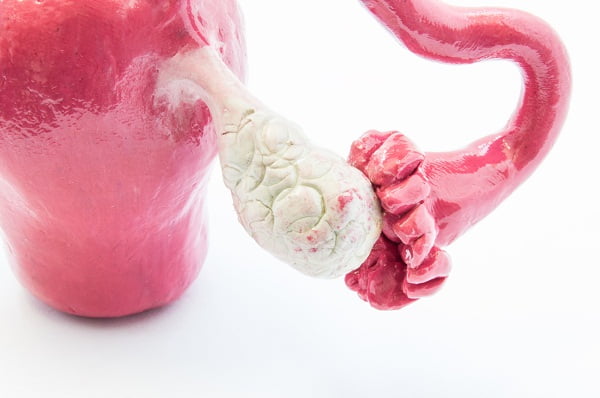
What is an ovarian cyst rupture? What types of ovarian cysts can burst?
Ovarian cysts are fluid filled sacs which grow in or on the ovaries. Some occur around menstruation time and clear up naturally (functional cysts). Others can remain there and grow in size to that of a grapefruit or larger.
Ovarian cyst rupture is a medical complication in which the cyst ruptures causing intense pain and internal bleeding in the pelvic region. Ovarian cysts rupture when there is too much fluid accumulation inside the sac and the sac cannot withstand the resulting pressure. The sac then simply tears, hence the rupture or burst.
Smaller cysts usually burst (rupture) spontaneously and heal naturally, you may not even be aware of their presence. If you experience symptoms it may feel like menstrual cramps in the lower abdominal region which may have started several days before the cysts rupture.
In some cases, the symptoms are very severe with persistent pain and internal bleeding and one must seek emergency medical attention. In such cases, a large cyst may have suddenly burst or twisted.
More: Ovarian Cyst Removal and Ovarian Cyst Surgery
More: Ovarian Cyst Pain Relief What Can I Do For Ovarian Cyst Pain
What are the causes of ovarian cyst rupture? What can cause an ovarian cyst to burst?
Generally, larger ovarian cysts tend to rupture. There can be various causes to ovarian cyst rupture including:
- Hormonal fluctuations especially during menstrual cycle are the most common cause of cyst rupture. You can track your ovulation period using an Ovulation Calculator. Functional cyst ruptures are usually harmless and do not need prompt medical attention.
- Chances of cyst rupture increases during pregnancy. To better understand your pregnancy timeline, you can use a Due Date Calculator. Non-traumatic rupture of ovarian cysts can be life threatening, especially if it occurs in the later stages of pregnancy. Read about affects of ovarian cysts on pregnancy.
- Women who are on anticoagulant therapy or those lacking a clotting factor are also at an increased risk of corpus luteum rupture due to coagulation abnormalities.
- Sometimes, larger cysts start leaking or get burst during or right after the sexual intercourse. This is one of the most common causes of cyst rupture.
- Straining for a bowel movement in constipation puts pressure on the cyst and it may rupture.
- Trauma and or direct hit to the area.
- Rapid and abrupt movement while exercising, playing a sport, and even bending down to pick up objects can cause the cyst to rupture.
When does an ovarian cyst require medical attention?
An ovarian cyst requires immediate attention if it becomes infected, leading to potential sepsis—a life-threatening response to bacteria. Women with pelvic inflammatory disease (PID), often due to sexually transmitted diseases like gonorrhea or chlamydia, have a higher risk of infected cysts that can rupture and cause sepsis. Another serious complication is ovarian torsion, where a cyst’s weight causes the ovary to twist, cutting off or reducing its blood supply, necessitating surgical intervention. Some ruptured cysts may resolve without treatment, but complications like these underline the importance of medical evaluation.
What are the symptoms of a ruptured ovarian cyst? What happens when an ovarian cyst ruptures?
A ruptured (burst) ovarian cyst is not always accompanied by symptoms, particularly if the cyst is small. However in case of large cyst, rupture symptoms include such as:
Intense abdominal pain
A ruptured cyst can causes a sharp and sudden pain in the lower abdominal area. In some women, it may feel like a numbing pain. It generally occurs on that side of the body where the cyst ruptures. Right sided ruptures of ovarian cysts have been seen dominant in various studies.
Bleeding
During periods ruptured cysts are more likely to happen. So, it is not infrequent to miss it as a symptom of ruptured cyst. Bleeding is a well known complication of a ruptured ovarian cyst. Significant bleeding can be potentially catastrophic. Bleeding is common symptom of functional cysts. According to research studies, corpus luteal cysts, in particular, have highly vascular walls, and this may cause significant bleeding.
Abdominal pressure and distension
Cysts may occupy a lot of space in the abdominal area and push the nearby organs causing a pressure on them. Though cyst rupture reduces the pressure, abdominal distension continues since the fluid leaks into the area, causing even more bloating.
Other symptoms of ruptured ovarian cyst
Nausea, vomiting, dizziness and low grade fever are some of the other common symptoms of ruptured cysts.
More: Causes of Polycystic Ovary Syndrome
More: Ovarian Cyst during Pregnancy How Do Ovarian Cysts Affect Pregnancy
What does it feel like when an ovarian cyst ruptures? How do you know if your ovarian cyst ruptures?
You may feel one of the following which is indicative of ovarian cyst rupture.
- extreme abdominal pain
- nausea and vomiting
- shoulder tenderness
- weakness
- vaginal bleeding
- syncope – temporary loss of consciousness
- circulatory collapse
Can a ruptured ovarian cyst cause brown discharge?
If you’ve had an ovarian cyst rupture, it’s possible you may experience a brown discharge; though there are many other reasons for brown spotting such as:
- Pregnancy
- Ovulation
- Sexual intercourse
- Vaginal infection
- Birth control pills
- Ectopic pregnancy
- Endometrial cancer
- Perimenopause
This usually occurs if you have had an endometriosis cyst, where tissue that usually covers the inner lining of the uterus is displaced to the ovaries and forms a cyst which is commonly known as chocolate cyst.
A chocolate cyst usually varies in size and can be small or large and contains dark blood. This dark coloured blood mixes with your vaginal discharge and form a black, dark or brownish looking discharge after the rupture of the cyst.






